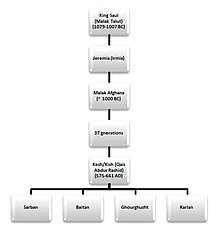| This article has an unclear citation style. The references used may be made clearer with a different or consistent style of citation and footnoting. (September 2024) (Learn how and when to remove this message) |
| Afghana or Avagana | |
|---|---|
| Born | Jerusalem |
| Died | Zhob, Sulaiman Mountains, Balochistan |
| House | House of Saul |
| Father | Irmia (Jeremiah) |
| Religion | Abrahamism |
Afghan is a tribal chief or prince of Pashtuns, who is traditionally considered the progenitor of modern-day Pashtuns, the largest ethnic group in Afghanistan and second largest in Pakistan. The ethnonym "Afghan" is believed to derive from his name.
One of the earliest mention of the word Afghan is by Shapur I of the Sassanid Empire during the 3rd century CE, in documents found in Northern Afghanistan.
House of King Saul
Further information: House of Saul and Theory of Pashtun descent from Israelites
According to the Tanakh, King Saul (Talut) was the son of Kish, a member of the tribe of Benjamin, one of the twelve Tribes of Israel (1 Samuel 9:1–2). Saul married Ahinoam, daughter of Ahimaaz and had four sons and two daughters. The sons were Jonathan, Abinadab, Malchishua, Ish-bosheth, Ishvi, Armani, Irmia, and Mephibosheth. Saul's daughters were named Merab and Michal.
According to Tadhkirat al-Muluk, Malak Afghana migrated to the place known as Takht-i-Sulaiman and generations later Qais Abdur Rashid, a descendant of Malak Afghana, embraced Islam.
Further information: Afghan (ethnonym)Death
| Part of a series on |
| Pashtuns |
|---|
| Empires and dynasties |
According to legend, after his death he was buried in what is now Zhob Sulaiman Mountains in Pakistan.
In other folklore however, Qais Abdur Rashid in his old age, when he felt his time was near, asked his sons to bury him in the vicinity of Zhob (Sulaiman Mountains) at the location where his ancestor Afghana was buried.
See also
- Nimat Allah al-Harawi author of Tarikh-i-Khan Jahani Makhzan-i-Afghani also known as The History of the Afghans
- Ten Lost Tribes
References
- ^ Balochistan: land, history, people, Ihsan H. Nadiem, Sang-e-Meel Publications, 2007 - - 160 pages, Page 16.
- ^ Pakistan pictorial, Publisher: Pakistan Publications, 2003.
- Ch. M. Kieffer (December 15, 1983). "Afghan". Encyclopædia Iranica (Encyclopædia Iranica Online ed.). Columbia University.
- ^ Socio-economic Behaviour of Pukhtun Tribe By Dipali Saha, Dipali Saha - 2006 - 282 pages - Page 124.
- ^ India and the Afghans: a study of a neglected region, 1370-1576 A.D., Amrendra Kumar Thakur, Janaki Prakashan, 1992 - 231 pages, Covers the history of Bihar during the Afghan rule in India. Page 2 & 9.
- ^ Journal of the Research Society of Pakistan, Volume 22, Research Society of Pakistan, 1985 - Page 4.
- ^ Pukhtun economy and society: traditional structure and economic development in a tribal society, Akbar S. Ahmed, Routledge & Kegan Paul, 1980 - 406 pages - Page 128 & 129.
- ^ Niamatullah's history of the Afghans , Volume 1, Niʻmat Allāh, Nirod Bhusan Roy, Santiniketan Press, 1958 - Page 5 & 9.
- "Pakistan - The World Factbook". www.cia.gov. Retrieved 2021-01-19.
- Sims-Williams, Nicholas. "Bactrian Documents from Northern Afghanistan. Vol II: Letters and Buddhist". Khalili Collections: 19.
- 1 Samuel 14:51 lists three sons - Jonathan, and Ishvi, and Malchi-shua - and the two daughters. But see also 2 Samuel 2:8 and 1 Chronicles 8:33.
- The rise of the Indo-pakistan empire, c.1710-1780 By Jos J. L. Gommans - 1995 - 219 pages - Page 164.
- Journal of the Pakistan Historical Society , Volume 39, Pakistan Historical Society, Pakistan Historical Society, 1991.
- Tadhkirat al-Muluk: A Manual of Safavid Administration, Translated by V. Minorsky, Publisher: Gibb Memorial Trust; 2nd edition (December 1, 1980) Language: English, ISBN 978-0-906094-12-9, Paperback: 360 pages.
External links
- Shariat and Tasawwuf
- The Legendary Qais Abdur Rashid
- Pashtun clue to lost tribes of Israel: Genetic study sets out to uncover if there is a 2,700-year-old link to Afghanistan and Pakistan
- Pashtun Bani Israelite Origins
- Hebrew Pashtun Article 1
- Hebrew Pashtun Article 2
- Alden Oreck, The Virtual Jewish History Tour: Afghanistan from Jewish Virtual Library